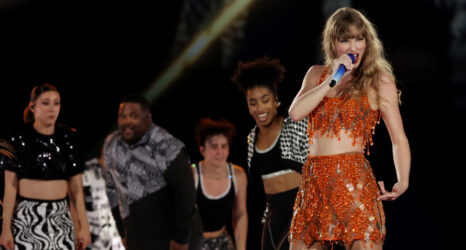Reading yesterday about the abrupt firing of Jill Abramson, along with the resignation of Le Monde’s Natalie Nougayrède, was like watching a ripple of misogyny move through the air in slow motion. Similar, in fact, to watching the slow, then fast, build to Australian Prime Minister Julia Gillard’s removal from office. There’s no way to examine these situations and ask, “Do women fear power and success?” Instead, the question is, “Why are powerful and successful women so feared?”
In their former positions, both Abramson and Nougayrède were notable firsts. Abramson was the first woman to head The New York Times as executive editor, and Nougayrède the first to be both editor-in-chief and director at French newspaper Le Monde. Both women, whose tenures have been prematurely cut short, are paying the price for our very gendered ideas about power and leadership. Because they are women with power, all Abramson and Nougayrède had to do in the morning to be disruptive was get out of bed.
They are counter-cultural, by definition. Both are experienced, accomplished, powerful, strong-willed, assertive, decisive and display–likeable or not–leadership qualities. Both were in the isolated position that most women with authority find themselves in. Both were navigating the high pressures of their professional lives while simultaneously challenging everyone’s–their employees’, their employer’s, the media’s– embedded notions of gendered behavior: from their “brusque,” “pushy” and “aggressive” dispositions, speech patterns, body language, ambition, confidence and more. The active coping that women leaders do in their work is qualitatively different and, frankly, more onerous than their male peers, whom they are most frequently told they should simply emulate to get ahead.
So it was with no small amount of wry humor that I read a front page New York Times headline today, “Labs Are Told to Start Including a Neglected Variable: Females,” about how medical researchers have ignored women and expected them to benefit from what men do. I’d be willing to bet a small fortune that copy editors at the Times assiduously purged words like “brusque,” “pushy” and “bossy,” from their digital galleys in the wake of yesterday’s news, but no one paused to consider (or, maybe they did), the relevance of the fact that “female” is not actually a variable. Variables are adaptations to norms.
The headline illuminated not just an intractable problem at the Times, but a persistent and widespread truth: We keep expecting women to be content being seen as and understood as variations on men.
Women in leadership, the relatively scant few, learn to adapt to the double bind that necessitates them rejecting much of what they were taught to think and be as females. Most girls, even those with egalitarian-minded parents, learn to put others first, to defer to dominant male speech in the public sphere, to cede physical space to not be disruptive. These are not valued characteristics or behaviors in most competitive, male-dominated work places. Women who do transcend their gender socialization and exhibit confident authority are inevitably penalized. Lack of deference in a woman is so unattractive.
The fact remains that most girls learn early that their well-being and success are inextricably tied to being attractive and being nice. Horrible as it is to so many people to consider, “nice”–a whole spectrum of behavior–is how we girls and women navigate our lower status and adapt to having vicarious and male-mediated access to safety, resources and power. Women’s adaptive behavior, language, dress, use of physical space are not the traits of “femaleness” but “powerlessness.” It’s why women and minorities “struggle” with “executive presence.” Women who defy these norms have no place in our gender-framed cultural schema.
The New York Times magazine demonstrated this earlier this year when it proved incapable of even graphically envisioning women with authority. Their cover photos of Hillary Clinton and Sarah Palin, both as disembodied heads adrift in a sea of chaos, were testaments to their complete and utter failure of imagination when it comes to women and leadership. The same is true across media, where powerful girls and women are most often portrayed as unnatural, supernatural beings like witches or vampires, mermaids or fairies. A close runner up, again–thank you, New York Times, for such singular examples–is that it is only possible to construct women in power in terms of “Where Mean Girls Rule.” Really, you cannot make this up.
It’s in our imagery and in our language. The words we associate with power are “male”–assertive, authoritative, decisive. Women are bitches, scolds, nagging, shrill, difficult, opinionated, bossy, cunts, ugly, aggressive, temperamental, pushy and more. Oh, did I leave out brusque? Sorry.
Children are socialized in binary, gendered ways. It’s why, despite 100 years of academic over-achievement, we still live in a world where men rule. Women don’t need to become more like men, a tactic that is easily used to undermine them every day. Power needs to become feminized, a strategy that the world would benefit from across the board. Here’s a quick fix: Let’s just call powerful women “men” and be done with this tiresome discrimination and rigid genderization. Calling women who lead “men” will trick our brains, saturated with denigrating and sexist stereotypes, the way mirrors trick amputees out of feeling phantom pain. While we are at it, we can call men who nurture “mothers,” thereby eliminating the systemic and thoroughly gendered impediments to equality in the workplace. These were the issues that Margaret Sullivan, The New York Times’ public editor herself, identified earlier this week in a “Where Are the Women” Times article.
Some people think that our “problems with women,” power and status are an “historic remnant of gender discrimination.” We aren’t living with remnants, we’re wrapped, bound and immobilized like mummies. The elimination of these two women from the paper-thin ranks of women in media leadership is a real loss, even though the hiring of Dean Baquet to replace Abramson is a notable and important landmark. (As New York Magazine put it in a headline begging for gender commentary, “Meet Dean Baquet, the NYT’s First Black Boss.”) Many believe Baquet was erroneously passed over by Abramson’s hiring in the first place. It is a particularly poignant shame that this happened within a week of Judith Cummings’ death (she was the first black woman to lead a news bureau for The Times). All of this smacks distastefully of our racist, sexist, pre-19th Amendment history of pitting white women and black men against one another. It sure feels like, while we parse whether or not to #BanBossy or embrace #GirlBoss, a whole lot of white men with power are having a chuckle and a smoke in a back room.
When she was Prime Minister of Australia, Gillard came to international attention as the result of a speech she made excoriating another politician for his sexism and misogyny. The speech resulted in an actual change in the Macquarie Dictionary of the definition of the word “misogyny” from “hatred of women” to include “entrenched prejudice of women.” No matter which definition you choose, and whether you locate the obstacles in explicit or implicit bias, the systemic exclusion of women from positions of power and leadership is a defining characteristic of misogyny.
Jill Abramson, brusque and pushy, did more to level the gender playing field at The New York Times than anyone before her. She created a gender-balanced editorial board and an environment where young women felt they could more equitably thrive. Score one for patriarchy and its global expression.
Photo courtesy of Michael V via Creative Commons 2.0
Soraya Chemaly is a media critic and activist whose work focuses on women’s rights, free speech and the role of gender in politics, religion and popular culture. Her work appears regularly in a variety of media, including Salon, CNN, Huffington Post and The Guardian.





